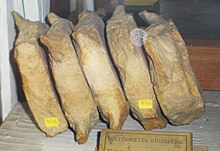Cetotheriidae
| Cetotheriidae Temporal range: Chattian–Recent |
|
|---|---|
 |
|
| Heterocetus guiscardii (nomen dubium) vertebrae | |
| Scientific classification | |
| Kingdom: | Animalia |
| Phylum: | Chordata |
| Class: | Mammalia |
| Order: | Artiodactyla |
| Infraorder: | Cetacea |
| Parvorder: | Mysticeti |
| Family: |
Cetotheriidae Brandt 1872 |
| Subfamilies and genera | |
|
See text |
|
See text
Cetotheriidae is a family of baleen whales (suborder Mysticeti). The family was generally thought to have existed from the Late Oligocene to the before going extinct. However, the phylogenetic studies conducted by Fordyce & Marx 2013 recovered the living pygmy right whale as a member of Cetotheriidae; if confirmed these results would resurrect Cetotheriidae from extinction.
After its description by Brant in 1872, Cetotheriidae was used as a wastebasket taxon for baleen whales which were not assignable to extant whale families.
Comparing the cranial and mandibular morphology of 23 taxa (including late archaeocetes and both fossil and extant mysticetes),Bouetel & Muizon 2006 found Cetotheriidae in this traditional sense to be polyphyletic. Based on ten cranial characters, they also concluded that of the twelve included fossil baleen-bearing mysticetes, six formed a monophyletic group, Cetotheriidae sensu stricto.
Several phylogenetic studies since Bouetel & Muizon 2006 support the monophyly of a small group of core Cetotheriidae sensu stricto, archaic mysticetes with a cranium that have "a long ascending process of the maxilla with anteriorly diverging lateral border that interdigitates with the frontal" and some other characters. This group is limited to Cetotherium rathkii, Metopocetus durinasus, Mixocetus elysius, Herpetocetus scaldiensis, H. transatlanticus, H. bramblei, Nannocetus eremus, and Piscobalaena nana. The remaining genera placed in the family are considered Cetotheriidae sensu lato and are often referred to as the 'cetotheres'.
Bisconti, Lambert & Bosselaers 2013 considered the primitive 'cetothere' Joumocetus the most basal named taxon of their new superfamily Thalassotherii (Cetotheriidae s.l., Cetotheriidae s.s., Eschrichtiidae (gray whales) and Balaenopteridae (rorquals)) and suggested that the term "Cetotheriidae s.l." should be renamed "basal" or "stem thalassotherians".Fordyce & Marx 2013 found that the pygmy right whale formed a well-supported clade with Eschrichtiidae and Balaenopteridae based on molecular data, and that, within 'cetotheres', it was most closely related to the herpetocetines ( and Nannocetus) Bisconti et al. 2013, however, found, based on morphological data, it to be more closely related to Balaenidae (the bowhead and right whales), but added that additional specimens is expected to resolve these conflicting results within a few years.
...
Wikipedia
